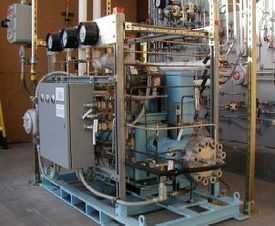Diaphragm compressor
A diaphragm compressor is a variant of the classic reciprocating compressor with backup and piston rings and rod seal. The compression of gas occurs by means of a flexible membrane, instead of an intake element. The back and forth moving membrane is driven by a rod and a crankshaft mechanism. Only the membrane and the compressor box come in touch with pumped gas. For this reason this construction is the best suited for pumping toxic and explosive gases. The membrane has to be reliable enough to take the strain of pumped gas. It must also have adequate chemical properties and sufficient temperature resistance.
A diaphragm compressor is the same as a membrane compressor.
Compression of hydrogen gas with a diaphragm compressor

The photograph included in this section depicts a three-stage diaphragm compressor used to compress hydrogen gas to 6,000 psi (41 MPa) for use in a prototype hydrogen and compressed natural gas (CNG) fueling station built in downtown Phoenix, Arizona by the Arizona Public Service company (an electric utilities company). Reciprocating compressors were used to compress the natural gas.[1]
The prototype alternative fueling station was built in compliance with all of the prevailing safety, environmental and building codes in Phoenix to demonstrate that such fueling stations could be built in urban areas.[1]
In the ionic liquid piston compressor many seals and bearings where removed in the design as the ionic liquid does not mix with the gas. Service life is about 10 times longer than a regular reciprocating compressor with reduced maintenance during use, energy costs are reduced by as much as 20%. The heat exchangers that are used in a normal piston compressor are removed as the heat is removed in the cylinder itself where it is generated. Almost 100% of the energy going into the process is being used with little energy wasted as reject heat.[2]
In other systems high pressure electrolysis is used.
See also
References
- ↑ 1.0 1.1 Alternative Fuel (Hydrogen) Pilot Plant Design Report (Report INEEL / EXT-O3-00976 of the Idaho National Laboratory of the U.S. Department of Energy)
- ↑ Linde Develops Ionic Compressor for More Efficient Compressed Hydrogen Storage